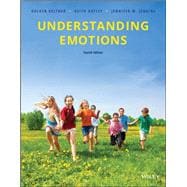Emotions are an inescapable part of the human experience. They motivate actions and reactions, guide our interpersonal and business relationships, inspire political and societal trends, and influence our sense of self and well-being. Emphasizing the broad practical reach of this field of study, Understanding Emotions draws from neuroscience, psychiatry, biology, genetics, the humanities, economics, and more to provide a strong foundation in core concepts. An easy-to-follow narrative arc encompasses the entire life span, while representative studies provide immediate insight into the real-world implications of important findings.
This new Fourth Edition continues to provide clear and concise guidance toward the factors that drive emotion, with new, revised, and expanded discussions that reflect the current state of the field. Detailed coverage of social and anti-social motivations, moral judgment, empathy, psychological disorders, the physiological components of emotion, and many more equip students with the conceptual tools to probe deeper into the material and apply methods and techniques to their own personal lives.








